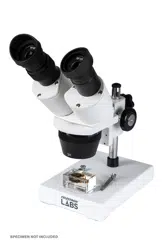
English
Congratulations on your Celestron Labs
microscope purchase. Your new Celestron
Labs microscope is a precision optical
instrument, made of the highest quality
materials to ensure durability and long
life. It is designed to give you a lifetime of
enjoyment with minimal maintenance.
The S10-30 microscope provides a low power
range of 10x to 30x. The S10-30 is a stereo,
low-magnification microscope ideal for
examining specimens such as coins, stamps,
rocks, electronics, jewelry, watches, insects,
and other 3D objects.
Before attempting to use your Celestron Labs
microscope, please read these instructions
to familiarize yourself with the parts and
functions of the microscope. Refer to the
microscope diagrams to locate the parts
discussed in the manual. The final section
of the manual provides simple care and
maintenance tips.
IN THE BOX
- Microscope S10-30
- 1 set of wide field eyepieces— (2) 10x
- 1 reversible stage plate
PARTS
1. Eyepieces
2. Diopter Control
3. Head
4. Objective Lens Housing
5. Stage Clips
6. Base
7. Pillar Locking Knob
8. Focus Knob
9. Stage
SPECIFICATIONS
STAGE: Stage Plate with clips
HEAD: Binocular with 45° incline
MAGNIFICATION: 10x, 30x,
FOCUSER: Coarse focus
OBJECTIVES: 1x, 3x
EYEPIECES: WF 10x
INTERPUPILLARY DISTANCE:
2.17 in - 2.95 in (55 mm - 75 mm)
WORKING DISTANCE: 2.17 in (55 mm)
DIMENSIONS: 4.75 in x 7.62 in x 11.50 in
(121 mm x 134 mm x 292 mm)
WEIGHT: 2.7 lbs (1.108 kg)
MAGNIFICATION TABLE
OBJECTIVE LENS: 1x 3x
WF 10X EYEPIECE: 10x 30x
SETTING UP YOUR
MICROSCOPE
1. Remove the Styrofoam container from the
carton.
2. Carefully remove the microscope and
accessories from container and set them
on a table, desk, or other flat surface.
3. Remove bag coverings from microscope.
4. Make sure the head (3) is parallel to the
base (6). If it is not, then hold the head
(3) with one hand and loosen the pillar
stand locking knob with the other, turning
it counterclockwise. Then rotate the head
until it is perpendicular to the base.
5. Remove eyepieces (1) from plastic bags.
6. Insert the two WF 10x eyepieces into the
eyepiece tubes on the binocular head (3).
7. If you do not wear eyeglasses, you can
install the rubber eyecups with the lips up
and facing outward. The rubber eyecups
will help stop extraneous light.
MICROSCOPE OPERATION
Before viewing specimens, please read these
sections thoroughly regarding focusing and
using the stage.
VIEWING A SPECIMEN
Stereo microscopes produce a true 3D image
of the specimen.
1. Carefully place a specimen in the center of
the stage plate.
2. Rotate the knurled ring on the objective
lens housing (4) to the 1x position. It is
best to begin viewing a specimen at low
power, then switch to higher power as
needed.
3. Look through the eyepieces and gradually
turn the focus knob (8) until the specimen
comes into focus. If there is not enough
travel in the focuser mechanism to reach
focus, it may be necessary to loosen the
pillar stand locking knob (7) and raise or
lower the entire binocular head assembly
until the image becomes sharp.
4. If higher power is desired, rotate the
objective lens housing (4) to the 3x
position and refocus until the specimen
becomes sharp.
NOTE: You may need to adjust the
interpupillary distance of the eyepieces
for better viewing. Rotate the eyepieces
up and down to adjust the eyepiece
distance. Close your right eye and
turn the left eyepiece diopter (2) until
the image is in sharp focus through
the eyepiece. Now the interpupillary
distance is set and you will only focus
with the focus knob (8).
ILLUMINATION
NOTE: You can further illuminate a specimen
by using an additional source of lighting
such as a flashlight, desk lamp, table
lamp, or bright overhead light.
CARE, MAINTENANCE AND
WARRANTY
Your Celestron Labs microscope is a precision
optical instrument and should be treated
with care at all times. Follow these care
and maintenance suggestions and your
microscope will need very little maintenance
throughout its lifetime.
• When you are done using your microscope,
remove any specimens left on the stage.
• Always place the plastic bag or dust cover
over the microscope when not in use to
help keep it clean.
• Store the microscope in a dry, clean place.
• Be very careful if using your microscope
in direct sunlight to prevent damage to the
microscope or your eyes.
• To carry your microscope, place one hand
on the “arm” of the microscope and the
other hand under the base for support. Do
not grasp your microscope by the focuser
knob or head.
• Clean the outside surfaces (metal and
plastic) with a moist cloth.
• Never clean optical surfaces with cloth or
paper towels as they can scratch optical
surfaces easily. Instead, use an air blower
or camel hair brush.
• To clean fingerprints off of optical surfaces,
use a lens cleaning agent and lens tissue
available at most photo supply stores. When
cleaning, do not rub in circles as this may
cause streaks or scratches.
• Never disassemble your microscope
or clean internal optical surfaces. Only
qualified technicians at the factory or an
authorized repair facility should attempt
these repairs.
• When handling glass specimen slides, use
care, as the edges can be sharp.
© 2021 Celestron • All rights reserved
celestron.com/support/warranties
(Products or instructions may change without
notice or obligation.)Designed and intended
for those 14 years of age and older.
Made in China
S1030
Model # 44138
1
3
2
4
6
5
7
8
9
Loading ...
Loading ...
Loading ...

